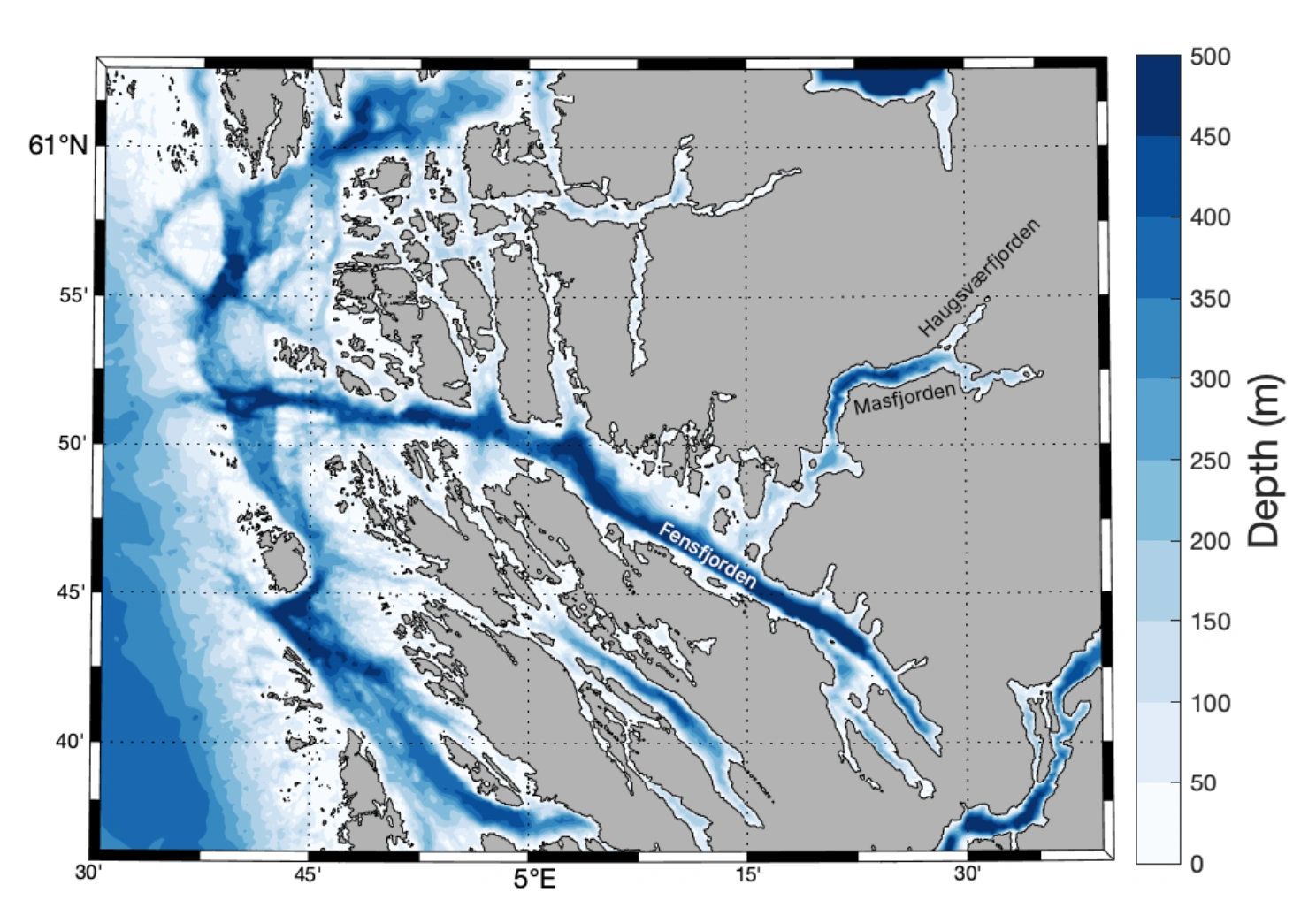Keeping an eye on the fjord
The water at the bottom of many fjords in Western Norway may remain stagnant for years, to be replaced within a few weeks. Masfjorden is one of these fjords.
Publisert 21. May 2025

Torunn Sandven Sagen has followed the development in Masfjorden since she was a student. She now works on a PhD about the fjord. Photo / Foto: Ellen Viste
When the water at the bottom of Masfjorden was renewed in April 2021, eleven years had passed since this last happened. Renewal of the water is vital for securing oxygen for life in the fjord.
"The fjord is cut off from what is happening on the coast. When the water is not replaced, the basin stagnates," says Torunn Sandven Sagen, a PhD candidate at the Bjerknes Centre and the Geophysical Institute at the University of Bergen.
With colleagues from the university and the Norwegian Institute of Marine Research, she recently published a study of the event in 2021. The fjord researchers have investigated whether a computer model of the Norwegian coast can recreate what happened when the bottom water in Masfjorden was renewed.

Masfjorden is a branch of Fensfjorden. Most fjords have a shallow sill at their mouth. Masfjorden has two such sills. Inside a sill at 70 meters' depth is a fjord basin of 300 meters. Then comes a sill at 170 meters before the water reaches the inner basin, 480 meters deep. Foto: Torunn Sandven Sagen
A wall at the opening
Masfjorden is a branch of Fensfjorden, north of Bergen and south of Sognefjorden. Like most fjords in Western Norway, it has a shallow sill at its mouth, like a wall against the sea outside.
"Masfjorden is a classic fjord, almost a textbook example," says Torunn Sandven Sagen.
The fjord has a distinct sill with a deep basin inside. Water passes back and forth over the sill, but renewal of the bottom water requires special conditions. Outside of the sill, dense coastal water must well up, then slosh over the sill and sink to the bottom of the fjord.
Even though the water at depth is dense and stable, it is affected by tidal waves. Gradually, the deep water is mixed with the water above, making it less dense. This builds up the potential for a renewal once conditions outside the fjord allow it.

In sill fjords the upper water masses flow in and out, while denser water remains as a distinct layer below. Renewal of the deepest water can only occur when denser water outside is brought high enough to slosh over the sill. Foto: Torunn Sandven Sagen
Winds of renewal
Together with observations, simulations with a coastal computer model showed how northerly winds created favorable conditions before the fjord water was replaced in 2021. The wind pushed the surface waters away from the coast, so that denser water welled up from the deep, all the way to the sill at the mouth of Masfjorden.
Masfjorden has not only one, but two, sills. To replace the water in the inner fjord basin, water from the outside must cross both sills. A complete renewal can take several weeks.

Steep mountain sides continue to the bottom of the fjord. Photo / Foto: Torunn Sandven Sagen
"The water does not reach the bottom immediately, but when water that is dense enough gets across the sill, it sinks straight down," says the fjord researcher.
In the spring of 2021, observations showed that such water crossed the outer sill. During the next ten days, the temperature in the deep water inside gradually increased.
After 28 days a leap in temperature occurred in the innermost basin, near the bottom, 470 meters below the surface. Within a few hours, the water was 0.15 degrees warmer.
In stable bottom water such a change does not happen frequently. Dense water from outside the fjord had reached their instruments.
The bottom water of Masfjorden had been renewed for the first time in eleven years.

The Norwegian Institute of Marine Research and the University of Bergen regularly have research cruises in Masfjorden. Photo / Foto: Torunn Sandven Sagen
Smells like rotten eggs
Researchers from the Norwegian Institute of Marine Research and the University of Bergen regularly visit Masfjorden. The oldest, long data series go back to the 1970s.
During the cruises, water samples are also taken. The oxygen concentration in Masfjorden is low without being critical.
However, in a branch of Masfjorden called Haugsværfjorden, the bottom sixty meters are devoid of oxygen.

Since 2019 the Geophysical Institute at the UiB has run annual student cruises to Masfjorden. Torunn Sandven Sagen has joined most of them. Photo / Foto: Ellen Viste
"The water from the bottom of Haugsværfjorden smells like rotten eggs," says Torunn Sandven Sagen. "Taking water samples there is not fun."
She does not want to guess when the water in Masfjorden will be renewed again.
"I believe it will take a while. But it would be interesting if it happened."
Those who want to study the renewal of fjord water, must be patient. Usually, eight to ten years will pass between each event.
For more on fjords, listen to this podcast!
References
Observations and modeling of the 2021 deep-water renewal event in Masfjorden, a sill fjord in Western Norway
